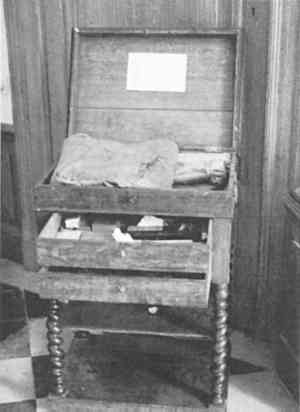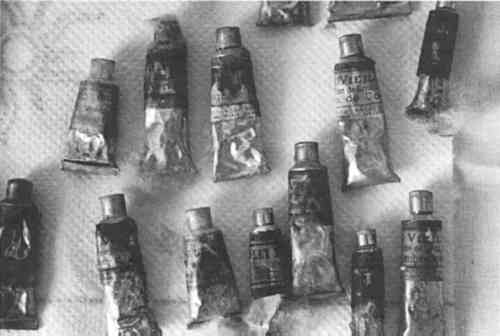PUVIS DE CHAVANNES'S ALLEGORICAL MURALS IN THE BOSTON PUBLIC LIBRARY: HISTORY, TECHNIQUE, AND CONSERVATIONTERI HENSICK, KATE OLIVIER, & GIANFRANCO POCOBENE
3 MATERIALS AND TECHNIQUEFirsthand accounts of the materials and techniques Puvis used for the murals come primarily from the writings of his students and contemporaries as Puvis himself revealed very little. The observations of conservators and art historians, combined with recent scientific analysis, provide additional information that corroborates much of what was written during Puvis's time. The preparatory studies and sketches Puvis created for the murals were an indispensable part of the final product; indeed, the sketches tell us most about his creative process. Prized in Puvis's day, many of the sketches for the Boston Public Library project were exhibited in the Salon of 1896. Geffroy reported that
Today, sketches for the library murals are preserved in numerous private and public collections. The Cabinet des Dessins at the Louvre houses five related works. Two of the small compositional studies, both about 10 x 33 cm (4 x 13 in.), are in ink over pencil on tracing paper. They reveal that Puvis did not at first conceive of the Muses as figures floating over the landscape but as figures standing firmly on the ground. In a third study at the Louvre (RF23070), Puvis raised the Muses as in the final design. This change was made so that the figures would not be truncated by the solid balustrade when seen from halfway up the staircase (Price 1994, 230). Puvis drew hundreds of life drawings from models in his studio. He used distillations of these sketches, squared up and transferred, for the figures in the murals. A drawing for one of the Boston Public Library Muses (the second figure from the left in The Inspiring Muses) reveals that Puvis carefully worked out the pose of the figure in a nude sketch (Petit Palais, P.P.D 274.1) before draping her in a robe in another sketch of the same size (Lyon Inv. B607–28). Puvis also made numerous small color studies for each mural project. He rendered his color ideas for the library murals in various media. In a study for Physics he painted in gouache on cardboard. Some sketches for the Muses were executed in oil on canvas, others in watercolor. The final step in the preparatory process was the creation of a full-scale painted cartoon combining many of the earlier studies. According to Puvis's student and collaborator Paul Baudouin, the cartoons Puvis produced for his mural projects “were very precise and studied works, in which all of the values were expressed” (Baudouin 1935, 300). Baudouin also noted that Puvis used either paper or canevas (a French word describing a coarse, light-colored cloth used for tapestry making) as a support for his large-scale cartoons. Notations on a photograph taken while the cartoon for the Inspiring Muses was on exhibit in the Salon of 1920, in the files of the Mus�e d'Orsay, indicate that the cartoon was painted in gouache on paper. The present whereabouts of the cartoon are unknown; its last location was in the attic of the Comic Opera, Paris (d'Argencourt et al. 1977, 231). Puvis executed the Boston murals on a plainweave linen canvas, typical of the type he generally chose for his monumental wall decorations. In the library murals the coarseness of the canvas is evident in many thinly or dryly painted passages. Puvis had access to immense canvases. Only two pieces of linen were used for The Inspiring Muses, each one measuring 4.88 m (16 ft.) high with the left half 8.81 m (28 ft. 11 in.) long and the right half 6.60 m (21 ft. 8 in.) long. Due to the light, unsaturated colors and almost matte surfaces of Puvis's murals, many people—beginning with the critic Th�ophile Gautier—have mistakenly referred to them as frescoes (Gautier 1861, 102–6). In fact, he appears to have experimented only once with pigments bound in lime on plaster. These works were painted (ca. 1853–54) at Le Brouchy, his brother's home outside of Lyon. Executed on an exterior wall, the paintings are now badly weathered. Puvis's success in achieving a frescolike appearance for his murals using oils can be explained by the combination of several techniques, starting with his grounds. Each library canvas was primed with a fairly thin ground layer of white chalk in a glue medium (see appendix 1). Various authors have described Puvis's grounds with the French term pl�tre (plaster), which refers generically to any sort of plaster, including lime and, hence, chalk. Grounds composed of chalk and glue have been found on most of Puvis's murals analyzed to date (Galinier 1995). The role of the ground in soaking up excess medium was duly noted in Puvis's time. According to one author, it was this highly absorbent ground “which gives his work that dead surface” (Hamerton, quoted in Crowninshield 1887, 105). Two of Puvis's contemporaries also suggest how he achieved the particularly frescolike appearance in his use of oil paints. According to the painter Frederic Crowninshield (1887), he deadened his oils by adding spirits of turpentine. Paul Baudouin (1935) writes that Puvis drained his oils by placing them on papier buvard (blotting paper). Baudouin also states emphatically that Puvis never added anything to his paints (no siccatives, copal, varnish, or any other ingredient). Each of these techniques, combined with the fond maigre (absorbent ground), would obviously produce a lean, matte paint with little if any excess oil. According to one contemporary observation, Puvis painted in “common oil-paints” (Crowninshield 1887). This fact was confirmed by the discovery of some of Puvis's leftover paint tubes in a paint box preserved by the artist's heirs at Le Brouchy (fig. 5). A list of the various colors found in the paint box is included in table 1. Puvis purchased paint from several different colormen and paint manufacturers in Paris. The tubes are tin with metal screw caps, which would date them after 1865 when screw caps began to replace the corks previously in use (Lefranc and Bourgeois 1990)(fig. 6). A box of six tubes is labeled “Exposition Universelle de 1889 Grand Prix.” Some of the tubes (from Gay and Lefranc) are labeled “ground in oil” while those from Bourgeois Ain�e are a “new preparation for painting in gouache.”
TABLE 1. TUBES OF PAINT FOUND IN PUVIS'S PAINT BOX AT LE BROUCHY Numerous authors have also suggested that Puvis achieved a matte appearance by adding wax to his painting medium. By the late 1840s, the use of wax was commonplace in French mural painting. Delacroix (at St. Sulpice), Hippolyte Flandrin (at St. Germain-des-Pr�s), and Chasseriau (at St. Roch) all painted � la cire(Baudouin 1914). In this technique, wax was either saponified with lime or dissolved in mineral spirits, making it usable without heat (B�guin 1981). According to his student Lasalle-Bordes, Delacroix added small amounts of wax to the oils on his palette as he worked at L'Assembl�e Nationale (S�rullaz 1995). There is no documentary evidence that Puvis mixed wax with his oils in this manner. Indeed, no wax was detected in the two samples from Puvis's Boston murals analyzed with gas chromatography (see appendix 1). Furthermore, solubility problems Puvis may or may not have been aware of the wax component in the tubes of paint he purchased. One of the samples that contained wax is from a tube labeled “ground in oils” and gives no indication of any wax additive. Carpentier (1875), among others, warned against mixing wax and oil because the wax stops the oil from drying and the oil stops the wax from hardening. By 1897, Lefranc advertised an oil paint that was “completely solid” containing “not an atom of wax” (Lefranc and Cie 1897). We can assume, therefore, that by the end of the 19th century, fewer and fewer color manufacturers added wax to their oils. To imitate the pale colors of fresco in his Puvis applied paint in a direct manner, often using just one or two layers. No glazes were observed in the murals, and only one of the numerous cross sections taken revealed a third layer. He textured his paint by various means: thick, dry impastos; thin, lean layers revealing the coarse texture of the canvas; passages of thick paint scraped flat; and incisions and scratches inscribed with various pointed tools or spatulas. Puvis also left some areas of canvas uncovered, especially outlining figures and trees, which often reveal what appears to be a charcoal underdrawing. The very few pentimenti visible in the Boston murals may well be explained by his thorough preparation or by his practice of scraping off unwanted passages rather than painting over them. Puvis recommended this practice to his followers: “Be fearful of useless impastos which darken, turn bluish and heavy. When you have painted a passage that you dislike, wait until it is possible to remove it. Judge it and if it is condemned, scrape it off firmly with a palette knife…. Excess paint is an abomination. In twenty four hours the gold will change to lead” (quoted in Vachon 1895, 57). It is highly unlikely that Puvis applied a varnish to his mural works. Ultraviolet light examination of his first mural cycle located at Le Brouchy has revealed that as early as the 1850s, Puvis chose not to apply a final varnish coating. The recent treatment and analysis of the Boston murals detected no original resin coating. As with many other questions of technique, Puvis appears to have written nothing at all about varnishing his paintings. His student Baudouin, who notes that Puvis never added varnish to his paint mixtures, also makes no mention of varnishing and adds that Puvis's Childhood of St. Genevieve (1876) in the Pantheon “gives the total illusion of frescoes” (Baudouin 1935, 300). The use of all these techniques produced the frescolike appearance so sought after by Puvis. He firmly believed that murals should not dominate an architectural space. To that end, he created paintings with minimal illusionistic depth by using light colors with unsaturated and unvarnished surfaces. Puvis chose colors that would harmonize with the library's marble staircase, and he flattened the figures and other elements to emphasize the two-dimensional nature of the wall. In Boston, as in France, Puvis's gigantic canvases were mounted to the wall using marouflage. The technique of affixing oil paintings on canvas to a wall or ceiling originated in 17th-century France (Mora et al. 1984). Thus the artist could work in the comfort and privacy of his studio, surrounded by his own paraphernalia. When the painting was finished it was usually rolled and delivered to the site for installation by a mural hanger. In French, maroufle refers to the sticky remnants of paint left in an artist's pots. The adhesive typically consisted of oils, resins, and fillers mixed into a thick paste. By the beginning of the 19th century, c�ruse (lead carbonate) was added to speed up the drying process (Mora et al. 1984, 157). For Puvis's murals at the library, lead white was a major component in the mounting adhesive. Although Puvis was not involved in the Boston installation, he did personally supervise the marouflaging of many of his murals in France. Paintings marouflaged with lead white paste are extremely durable and often show no signs of cracking. Puvis's murals in Amiens and in the Boston |

